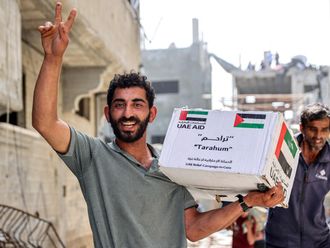Washington: While it’s tempting to imagine them as a disorganised horde, the reality of Daesh — the extremist Islamist group who have taken over vast swathes of Syria and Iraq — is that the sheer scale of their military operations, not to mention their caliphate ambitions, are not possible without some kind of organised leadership structure.
In a new report on Daesh, the Soufan Group has broken down graphically what we know about its leadership structure. It’s a fascinating glimpse of how the group that has captured so much of the world actually operates (a full chart is viewable at Soufan Group’s website).
First, there’s the leadership. At the top there is the Caliph, Abu Bakr Al Baghdadi (also known as Ebrahim Awad Ebrahim Al Badri Al Samarrai), who is no doubt the best known member of Daesh so far. He is the overall leader of Daesh.
The Soufan Group then points to two other men: Abu Muslim Al Turkmani (Fadil Ahmad Abdallah Al Hayyali) who oversees Daesh in Iraq, and Abu Ali Al Anbari, who oversees it in Syria. Both of these men are former members of the Iraqi Baath Party, the report notes.
Al Turkmani and Al Anbari are believed to be members of the Shura Council, Daesh’s highest advisory body. In theory, Al Baghdadi must run decisions past the Shura Council, which could dismiss the Caliph if it he fails to carry out his duties. The council is headed by Abu Arkan Al Ameri and has nine to 11 members, all of whom are believed to be from Iraq. Another possible member of the Shura Council is Omar Al Shishani (aka Tarkhan Tayumurazovich Batirashvili), a well-known ethnic Chechen who is distinctive for his red beard and reports of his fighting prowess (the Soufan Group cast some doubt on whether Al Shishani, a military commander, is a member of the council).
The most powerful body of Daesh, however, is the Sharia Council, which is said to have six members. It is the body that selects the Caliph and oversees Sharia. Daesh is also said to have recruited a number of religious scholars to help boost its legitimacy.
Alarming
Below that level are the other, less important councils. For example, there’s the Security and Intelligence Council, designed to maintain Abu Bakr’s control and stop any plots against him. Then there’s the Military Council, designed to help fight external forces, and the Provincial Council deals with civilian administration of Daesh’s 18 provinces (it is led by Al Turkmani, and each province has a governor known as a Wali).
The Finance Council, the Media Council and the Religious Affairs Council are self-explanatory, and the Soufan Group also believes there may be a council dedicated to looking after soldiers and their families.
Finally, the Soufan Group highlights a number of officials who have specific roles in Daesh. Abdul Rahman Al Afari is a member of the military council who is responsible for the families of dead soldiers, for example; Abdullah Ahmad Al Mishhadani coordinates guest houses for foreign fighters. Abu Yahya Al Iraqi is with Al Baghdadi at all times and acts as a channel between the Caliph and Abu Ali Al Anbari.
This leadership structure may seem complicated, but given the size of the land Daesh has, plus the number of soldiers it now has (as many as 31,500 according to CIA estimates), such a leadership apparatus is probably necessary. What’s more alarming is that, as the Soufan Group readily admits, the scope of what we know about Daesh’s leadership is limited and hard to verify. “Even if a report is accurate one day, it may change the next,” the Soufan Group’s report notes.










